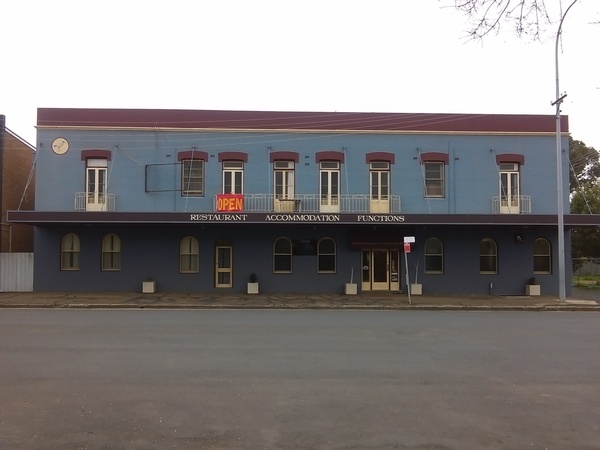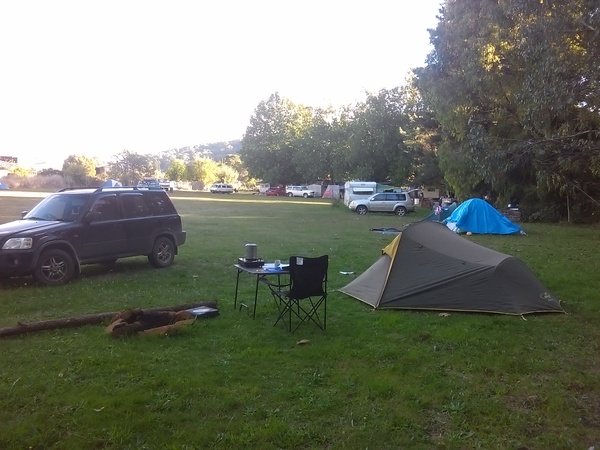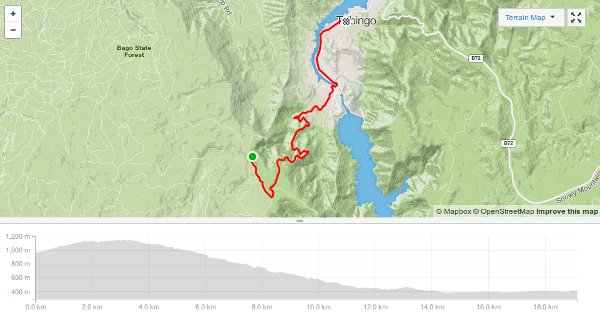29th Dec 2017 – 1st Jan 2018 – Khancoban and surrounds
The last weekend of 2017 saw me and my Beloved camping at Khancoban, in New South Wales. Part of the reason we went camping was to try out our new 4 man tent. But Rebecca (my Beloved) suggested that I find some things for us to do over the weekend, so being a good husband I did as I was told. Khancoban is the south-western gateway to the Kosciusko National Park, which has plenty of exciting and beautiful places to visit, a lot of them requiring hiking or mountain biking to see. There are also a number of National Parks and State Parks not far away in Victoria. So thats what I happened to find – lots of walking as I didn’t think I would be taking my mountain bike. My Darling is not much of a walker, but she was willing to accommodate my planned activities, at least as far as she was able. When we arrived at Khancoban, the weather was looking a bit threatening, with low clouds. And in the evening and overnight we had a lot of rain. We discovered that our tent leaked, although it required a significant downpour for that to occur, and it’s possible that we didn’t put it up properly in the first place.
On Sabbath, with the bad weather having cleared away and the weather looking promisingly sunny, we drove to the Burrowa-Pine Mountain National Park on the Victorian side of the Murray River near Cudgewa. We had only been there once before, and due to flood damage many of the tracks were closed at that time. This time the tracks were open. So we started by hiking to Bluff Falls and having look at them. Then it was up, up, up to Campbells Lookout. This track really wasn’t exactly what I was expecting. Although to be honest I didn’t really know what to expect. The track had lots of stairs, lots of scrambling over rocks, it even had a 5 metre or so vertical ladder to get up one particular section. Quite an adventure. But the scenery was magnificent, with great views, dramatic rock faces and formations, and fern gullys punctuated by the creek which runs down the middle of the valley.
Following the Campbells Lookout walk, we had some lunch then engaged in the much more leisurely pursuit – going for a drive through the countryside. And then we returned to Khancoban Caravan Park. While my Darling had a rest (ie, sleep), I went for a bit of a walk over the Khancoban Lake wall and into Khancoban itself, just to see what was around. There were boats and water-skiers in abundance on the lake. The Rose Garden in town looked like it had seen better days, but maybe that’s because it was being prepared for the next Rose season. In any case, the walk was interesting. And by the time I got back to the caravan park it was approaching dinner time.
On Sunday, New Years Eve 2017, the plan was to drive up the trail head near Tooma Dam, and then walk out to Paton’s Hut. But as is often the case, plans don’t always eventuate. We got to the trail head ok, and hiked most of the way, probably to within about 400 metres of the Hut, then Rebecca got bitten by something (no, not a snake!), and rather than complete the walk it seemed best to return to the car. It was a case of so close, yet so far. Rebecca suggested I go on another walk while she sat in the car and read a book, but I didn’t particularly like that idea, just case she had some sort of alergic reaction to the bite. So we drove back towards civilisation. At Corryong we had some lunch, and then we went and had a look at the Man From Snowy River Museum in the town.
Then it was back to Khancoban, where we found a nice shady spot and watched the boats, jet skis and water skiers enjoying themselves on the lake while we indulged in an ice cream and sat in the shade, at least for a while. Then we went back to the caravan park. At the caravan park, they had a Pizza night as a way of celebrating New Years Eve. And it seems that New Years Eve celebrations went on for a lot longer as every time we woke up during the night it seemed that there was loud music playing somewhere. Until the wee hours of the morning.
6th – 7th January – Bogong High Plains / Dinner Plain.
On the weekend of the 6th and 7th January, 2018, it was going to be hot. At least down on the plains where we live in Culcairn. On Sabbath I decided I wanted to go for a walk, and my Darling wife suggested I camp somewhere overnight to try out my new hiking tent. I didn’t take much convincing! Within about an hour I had enough food for an overnight camp, all my camping stuff and clothes suitable for hiking. And so I headed for the mountains. The plan was to drive to Dinner Plain, just downhill a ways from Mt Hotham, and do some hiking there then find a place to camp overnight. After looking at maps I decided I would walk the Carmichael Falls walk and then depending on how I felt and how hot it was I would consider another walk. The Carmichael Falls walk from Dinner Plain isn’t that long, but it turned out to be quite steep. It was like walking through a well tended rock garden with beautiful flowers, ferns and other types of plants everywhere. And then there was the falls themselves. They weren’t overly spectacular as it was the middle of Summer. But the rocks from which they fall was definitely worth the walk. Then on the way back I took a short detour to another cascade that looked distinctly man-made with the creek cascading over very symetrical rock steps. Although I’m pretty sure it was completely natural.
After completing the Carmichael Falls walk, I decided I would walk to Precipice Plains lookout. By comparing the distance on the map for the Carmichael Falls walk I figured it would be about 10km return from the Carmichael Falls track. And as it turns out I was pretty close. By this time of the day it was getting warm-ish, but still nowhere near as hot as it would have been at home. Precipice Plains is a geological feature where the Dargo River valley is surrounded by high cliffs. I guess thats where the “Precipice Plains” name comes from. The walk itself was along a 4WD track with alpine forest on both sides. It was quite a pleasant walk, with a breeze blowing across the track most of the time and shady sections where the trees overhung the track. As the wind was quite strong at the lookout I stayed well clear of the edge of the precipice. But even so, the views across to the cliffs north and west of the lookout were quite spectacular.
After I returned to the car, I decided I would check out the JB Plain camping area. It was rather pleasant, and it would have been even more pleasant and quiet as there was no-one else there. But I decided I would drive to Anglers Rest, on the Cobungra River, and camp there instead. This meant driving down to Omeo from Dinner Plain and then driving along the Omeo “Highway” north to Anglers Rest. I knew there were a number of camping spots there. I didn’t realise how busy the camping area just down the road from the Blue Duck Inn would be, but I managed to find a spot for my small hiking tent.
The name “Anglers Rest” is very descriptive of the area, and is a popular fishing spot as it is near the junctions of 4 rivers – Mitta Mitta, Cobungra, Bundarra and Big Rivers. People travel from some very long distances just to fish in the area. The area is also popular for horse riding, mountain biking, white water rafting, camping and hiking. It is nestled near the bottom of the valley, and is very picturesque. But the Omeo “Highway” is not for the faint hearted. It was even more of an adventure in the Gold Rush days as it was only a walking track then between Omeo and the Mt Wills goldfields. Even though it’s all asphalted now, it’s still quite an adventure as it is narrow and winds it’s way around the mountains to connect Omeo in the south and Mitta Mitta in the north.
After a fairly restful night, I rose early and had breakfast, packed up camp and drove to the Bogong High Plains near Falls Creek. My first walk for the day was the Mt Cope walk. It wasn’t very long, being 3km return, but the walk was along a very picturesque trail and the 360 degree views from the summit were well worth the effort. Along the way I chatted with an Army person who had his full combat uniform complete with helmet and what appeared to be a very heavy army-issue backpack. He wasnt hiking very fast, but then you wouldn’t expect him to with all the weight he must have been carrying. He was able to identify most of the mountains around, including Kosciusko many kilometres away. He also told me of some good hikes around Falls Creek and Bogong High Plains, which wet my appetite for some more adventures in the area.
After the Mt Cope hike, I drove a little way towards Falls Creek, and parked the car for a hike to 2 alpine huts. Huts in alpine areas of Australia generally fall into about 3 categories – 1) huts built by cattlemen many years ago to aid in the movement of cattle between the high plains and the valleys (and possibly rebuilt after a bush fire or something else requires it), 2) huts built by government agencies such as the National Park service for the use of visitors (for example, snow skiers), and 3) huts built by other organisations such as schools or clubs. I’ve been very interested in alpine huts ever since I acquired and read a book about the mountain cattlemen and huts of the high plains. Interest in alpine huts also increased in my early adult years due to another book I read about the history of snow skiing in Australia which talked about various huts in it’s narrative, and my own personal interest in and enjoyment of snow skiing (before I met Rebecca I went snow skiing whenever I could, often every Sunday). Movies such as the “Man from Snowy River”, which featured the beauty of Australia’s alpine areas also played a part in my interest. The two huts I visited on the Bogong High Plains that day, Wallaces and Cope Huts, seem to be huts initially built by cattlemen.
Up in the Boging High Plains that Sunday was very pleasant – around 25 degrees Celsius. When I stopped briefly in Mt Beauty on the way home, it was certainly a lot hotter than when I was hiking in the high plains.
A plan not realised
Over the Australia Day weekend in late January I had a plan to head for the hills again, and had sort of set my mind to camping and exploring the Snowy Mountains / Kosciusko National Park near Jindabyne, New South Wales. I had all the camping gear packed, all the food purchased and was all mentally prepared. And then rain, thunderstorms, and the like were forecast for exactly where I planned to go. So I checked other places such as around Falls Creek and Mt Hotham – the same sort of weather was forecast. I checked the forecast for some places outside the mountains, and the forecast there was for 35+ degrees Celsius. I realised that I could either risk getting caught in electrical storms and being stuck in a hiking tent during the forecast rains, or risk getting severly sunburnt, or stay home. Guess which one I chose?


























































































































































































































































































